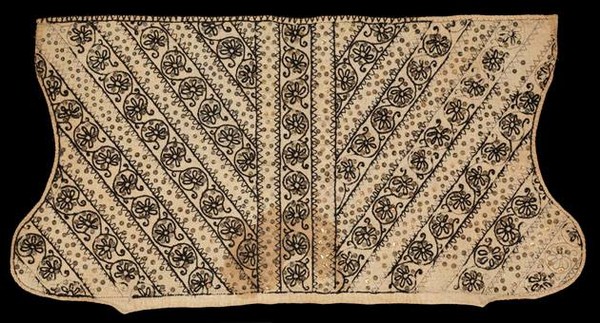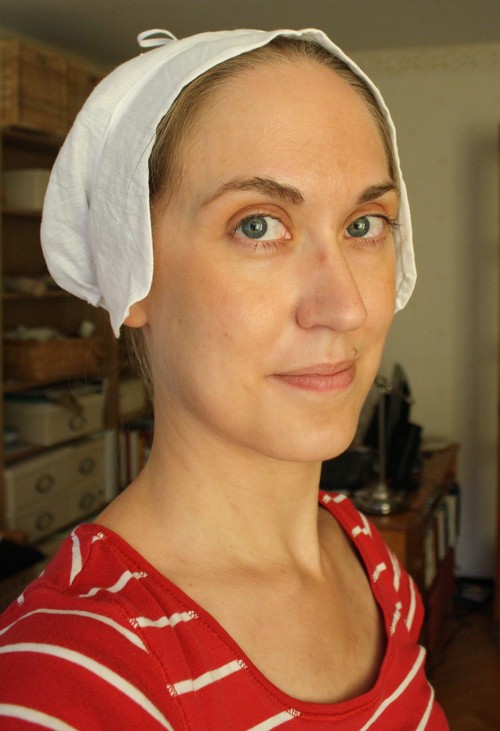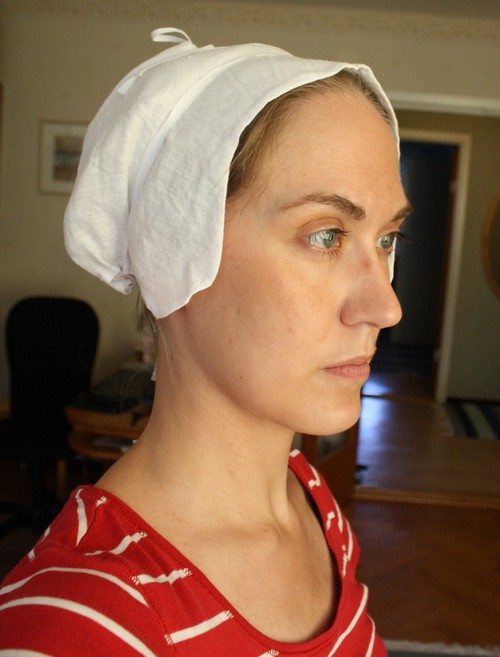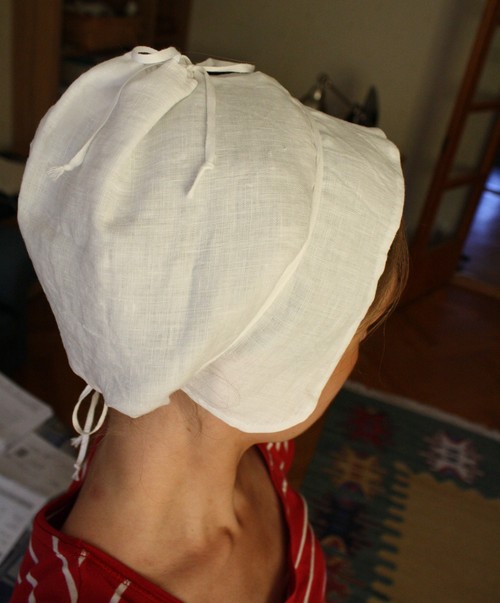The quest for a nice coif
Kategori: Allmänt, Historic Sew Monthly 15
Two things elude me: a coif that works nicely AND is period for the rest of my wardrobe, and a nicely fitting partlet (be it a linen or a wool one). I might get there eventually. I originally planned for garters and a belt for the Accessorise challenge, but on a whim, more or less the evening before departure to the LARP in late July I decided to try out a new coif pattern. Not that I'd be likely to wear one, really, but because I wanted something small and linen and ladylike to work on in-game. Or not to work on, but pretending to. Earlier, I've tried out the pattern for a coif with wired brim from Tudor Tailor, and liked it. Only thing with that is that its hard to keep in shape and to wash between events, and also tend to stand ot a bit too much around the ears.
(Apparently, there's this discussion going on as to whether the oorijzers used in the Low countries have been used elsewere. I don't know nearly enough to weigh into that discussion: it makes sort of sense, but the coifs in Tudor tailor seems to be meant to be worn without them).
So. What else to try? There are dozens of exant coifs, says my feeble google skills, that are made in about the same way as this one from the Burrell Collection in Glasgow:
 For those of you who, like me, have to do quite a bit of mulitdimensional geometry in their heads seeing how this flat piece of fabric becomes headwear, I'll try to explain. The TOP horisontal edge in the picture is the top of the coif. The coif is folded along the vertical line in the middle and the horisontal edge is thereby folded in half and stitched together. This means that the curved edges on each side frame the face, with the "bulges" in the bottom corners covering the ears. The BOTTOM horisontal edge is gathered by a string in the nape of the neck. Also the top seam is gathered to get rid of the "peak" that is otherwise formed on the back of the head. Clearer? I guess not, I'm sure I used too many words just now.
For those of you who, like me, have to do quite a bit of mulitdimensional geometry in their heads seeing how this flat piece of fabric becomes headwear, I'll try to explain. The TOP horisontal edge in the picture is the top of the coif. The coif is folded along the vertical line in the middle and the horisontal edge is thereby folded in half and stitched together. This means that the curved edges on each side frame the face, with the "bulges" in the bottom corners covering the ears. The BOTTOM horisontal edge is gathered by a string in the nape of the neck. Also the top seam is gathered to get rid of the "peak" that is otherwise formed on the back of the head. Clearer? I guess not, I'm sure I used too many words just now.

This one's dated 1610-1620 - so a bit late for me, alas, even if they were around also in the late 1500's.
The curved edge can have a lot of shape, making either a coif that sits far back on the head or creates a peak over the brow. Or both. I went for more or less this basic version, helped by a pattern diagram from Janet Arnold's Patterns of fashion 4. That pattern hadn't a channel for the string in the neck and on the top of the back of the head, but small loops of ribbon, so I decided to use that.
As this was the first time round, I didn't do anything fancy. A simple linen coif, and since I had no good ribbon I used thin, white cotton ribbon both for tying the coif and making the small loops. The results are, so far, promising.

Please ignore my very un-period t-shirt. The size is about right, but the "ear-flaps" are still... well, flappy. Securing them wouldn't be bad. Despite the drawstring in the back helping a lot with the fit.

I put my hair up for this: two braids tied round the head. My hair is a lot too short to do this properly, the ends barely meet on the top of my head, but after braiding I use a cheat-y round, elastic comb to secure everything and once I wrap the ribbons a few times round my head the comb makes it so secure that I don't even need hairpins. The ends of the braid are kept down by the coif itself. It stays all day, I used the same method under the hairnet with the blue dress.

Side view. I was a bit sloppy when putting my hair up. A forehead cloth of some sort would make this a non-issue. The ends of the string that goes round the head could (should?) of course be tucked in in the back. Here you can also see the drawstring that gathers the back of the coif.

Back. More hair would fill it out better, but I'm ok with this look.
What the item is: A linen coif
The Challenge: Accessorise
Fabric: White linen
Pattern: from Janet Arnold's Patterns of fashion originally, I think, also adapted from a couple of photos of extant coifs.
Year: Late 16th/early 17th century
Notions: White cotton ribbon. No white linen ribbon to be found!
How historically accurate is it? Apart from the cotton and me not being entirely sure about the fiber content of the thread, I'd say 90%.
Hours to complete: Perhaps four or five. The addition of the small loops for the ribbon was surprisingly time-consuming. Maybe because I watched Wolf Hall at the same time and was very distracted indeed. The same goes for the in-game sewing at the larp.
First worn: Not yet.
Total cost: Next to nothing, it uses so little fabric. Maybe 3 euros including the ribbon?
The Challenge: Accessorise
Fabric: White linen
Pattern: from Janet Arnold's Patterns of fashion originally, I think, also adapted from a couple of photos of extant coifs.
Year: Late 16th/early 17th century
Notions: White cotton ribbon. No white linen ribbon to be found!
How historically accurate is it? Apart from the cotton and me not being entirely sure about the fiber content of the thread, I'd say 90%.
Hours to complete: Perhaps four or five. The addition of the small loops for the ribbon was surprisingly time-consuming. Maybe because I watched Wolf Hall at the same time and was very distracted indeed. The same goes for the in-game sewing at the larp.
First worn: Not yet.
Total cost: Next to nothing, it uses so little fabric. Maybe 3 euros including the ribbon?

